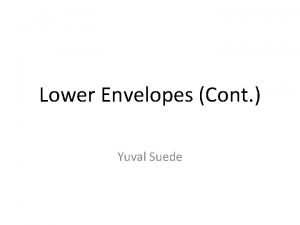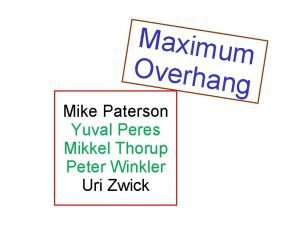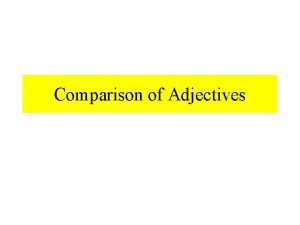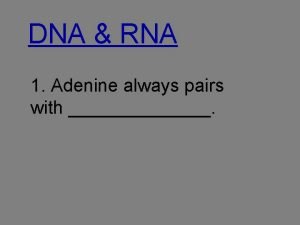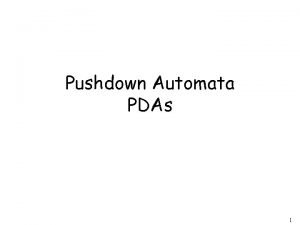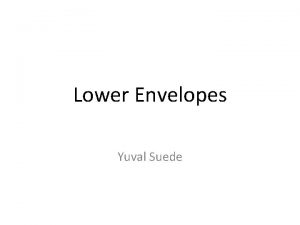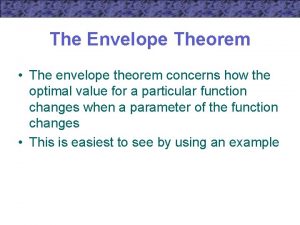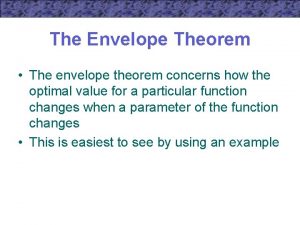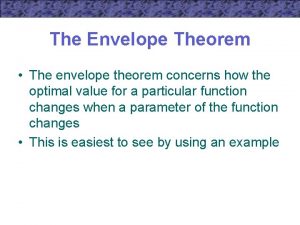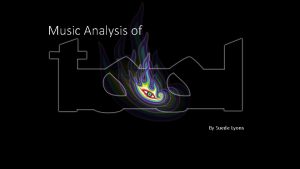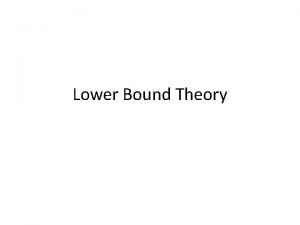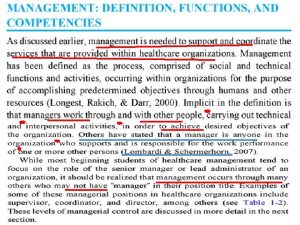Lower Envelopes Cont Yuval Suede Reminder Lower Envelope


























- Slides: 26

Lower Envelopes (Cont. ) Yuval Suede

Reminder • Lower Envelope is the graph of the pointwise minimum of the (partially defined) functions. • Let be the maximum number of pieces in the lower envelope.

Reminder • Each Davenport-Schinzel sequence of order s over n symbols corresponds to the lower envelope of a suitable set of n curves with at most s intersections between each pair. • DS sequence important property: – There is no subsequence of the form

Reminder • Let be the maximum possible length of Davenport-Schinzel sequence of order s over n symbols. • Upper bound:

Towards Tight Upper Bound • Let W = a 1 a 2. . al be a sequence • A non-repetitive chain in W is contiguous subsequence U = aiai+1. . ai+k consisting of k distinct symbols. • A sequence W is m-decomposable if it can be partitioned to at most m non-repetitive chains.

Towards Tight Upper Bound • Let denote the maximum possible length of m-decomposable DS(3, n). • Lemma (7. 4. 1): Every DS(3, n) is 2 n-decomposable and so

Towards Tight Upper Bound • Proof: – Let w be a sequence. We define a linear orderingon the symbols of w: we set a b if the first occurrence of a in w precedes the first occurrence of b in w. – We partition w into maximal strictly decreasing chains to the ordering – For example: 123242156543 -> 1|2|32|421|5|6543

Towards Tight Upper Bound • Proof (Cont. ) – Each strictly decreasing chain is non-repetitive. – It is sufficient to show that the number of nonrepetitive chains is at most 2 n.

Towards Tight Upper Bound • Proof (Cont. ) – Let Uj and Uj+1 be two consecutive chains: U 1. . Uj Uj+1. . – Let a be the last symbol of Uj and (i) its index and let b be the first symbol of Uj+1 and (i+1) its index : a b U 1. . Uj Uj+1. .

Towards Tight Upper Bound • Claim: – The i-th position is the last of a or the first of b – if not, there should be b before a (b. . ab) – And there should be a after the b (b. . a) – And because of there should be a before the first b (otherwise the (i+1)-th position could be appended to Uj). – So we get the forbidden sequence ababa !!

Towards Tight Upper Bound • Proof (Cont. ) – We have at most 2 n Uj chains, because each sybol is at most once first, and at most once last.

Towards Tight Upper Bound • Proof (Cont. ) – We have at most 2 n Uj chains, because each sybol is at most once first, and at most once last.

Towards Tight Upper Bound • Proposition (7. 4. 2) : Let m, n ≥ 1 and p ≤ m be integers, and let m = m 1 + m 2 +. . mp be a partition of m into p addends, then there is partition n = n 1 + n 2 +. . + np + n* such that:

Towards Tight Upper Bound • Proof: – Let w = DS(3, n) attaining – Let u 1 u 2. . um be a partition of w into non-repetitive chains where : w 1 = u 1 u 2. . Um 1 w 2 = um 1+1 um 1+2. . Um 2 … wp

Towards Tight Upper Bound • We divide the symbols of w into 2 classes: • A symbol a is local if it occurs in at most one of the parts wk • A symbol a is non-local if it appears in at least two distinct parts. • Let n* be the number of distinct non-local symbols • Let nk be the number of local symbols in wk

Local Symbols • By deleting all non-local symbols from wk we get mk-decomposable sequence over nk symbols (no ababa) • This can contains consecutive repetitions, but at most mk-1 (only at the boundaries of uj) • We remain with DS sequence with length at most (the contribution of local-symbols):

Non-local Symbols • A non-local symbol is middle symbol in a part of WK if it appears before and after Wk • Otherwise it is non-middle symbol in Wk

Non local -Contribution of middle • For each Wk: – Delete all local symbols. – Delete all non-middle symbols. – Delete all symbols (but one) of each contiguous repetition (we delete at most m middle symbols) – The resulting sequence is DS(3, n*) • Claim: The resulting sequence is pdecomposable.

Non local -Contribution of middle • Each sequence Wk cannot contain b. . a. . b there is a before and a after • Remaining sequence of Wk is non-repetitive chain. • Total contribution of middle symbols in W is at most m +

Non local -Contribution of non-middle • We divide non-middle symbols of Wk to starting and ending symbols. • Let be the number of distinct starting symbols in Wk. A symbol is starting in at most one part, so we have • We remove from Wk all but starting symbols and all contiguous repetitions in each Wk.

Non local -Contribution of non-middle • The remaining starting symbols contain no abab because there is a following Wk • What is left of Wk is DS(2, ) that has length at most 2 -1 • Total number of starting symbols in all W is at most

Towards Tight Upper Bound • Summing all together:

Towards Tight Upper Bound • The recurrence can be used to prove better and better bound. • 1 st try: we assume m is a power of 2. • We choose p=2, m 1=m 2= and we get : Using we estimate the last expression by

Towards Tight Upper Bound • 2 nd try: we assume (the tower function) for an integer • We choose and • Estimate using the previous bound. • This gives:

Towards Tight Upper Bound • • • If then We chose Recall that And since We get that so

Tight tight Upper Bound • It is possible to show that : • But not today …
 Lower envelope
Lower envelope Cont or cont'd
Cont or cont'd Cont or cont'd
Cont or cont'd Hair perforation test is positive in infection with
Hair perforation test is positive in infection with Numero 11 suede
Numero 11 suede Yuval yarom
Yuval yarom Yuval peres
Yuval peres Yuval madar
Yuval madar Yuval binur
Yuval binur Netalee
Netalee Yuval binur
Yuval binur Please check all envelopes for the correct return
Please check all envelopes for the correct return A thin gaseous layer that envelopes the earth
A thin gaseous layer that envelopes the earth Warm up questions and answers
Warm up questions and answers I just collect stamps from discarded envelopes
I just collect stamps from discarded envelopes I693 reminder letter
I693 reminder letter Adjectives for reminder
Adjectives for reminder Stir you up by way of reminder
Stir you up by way of reminder Pda reminder 1
Pda reminder 1 Sql reminder
Sql reminder Growth mindset crumpled paper activity
Growth mindset crumpled paper activity Reminder symbol
Reminder symbol Phytel appointment reminder
Phytel appointment reminder Adenine
Adenine In the story’s resolution (the end), charlie —
In the story’s resolution (the end), charlie — Binder reminder
Binder reminder Pda reminder 1
Pda reminder 1
